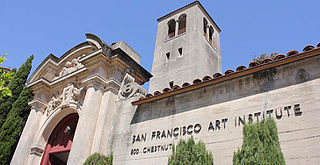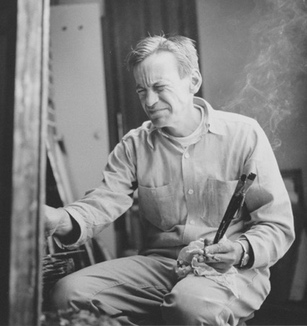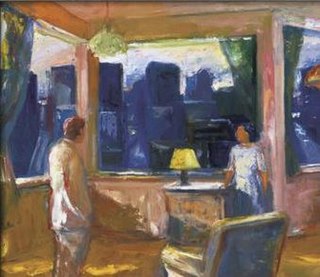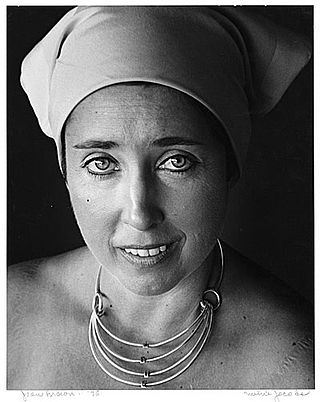
San Francisco Art Institute (SFAI) was a private college of contemporary art in San Francisco, California. Founded in 1871, SFAI was one of the oldest art schools in the United States and the oldest west of the Mississippi River. Approximately 220 undergraduates and 112 graduate students were enrolled in 2021. The institution was accredited by the Western Association of Schools and Colleges (WASC) and the National Association of Schools of Art and Design (NASAD), and was a member of the Association of Independent Colleges of Art and Design (AICAD). The school closed permanently in July 2022.

Richard Diebenkorn was an American painter and printmaker. His early work is associated with abstract expressionism and the Bay Area Figurative Movement of the 1950s and 1960s. In the late 1960s he began his extensive series of geometric, lyrical abstract paintings. Known as the Ocean Park paintings, these paintings were instrumental to his achievement of worldwide acclaim.

Color field painting is a style of abstract painting that emerged in New York City during the 1940s and 1950s. It was inspired by European modernism and closely related to abstract expressionism, while many of its notable early proponents were among the pioneering abstract expressionists. Color field is characterized primarily by large fields of flat, solid color spread across or stained into the canvas creating areas of unbroken surface and a flat picture plane. The movement places less emphasis on gesture, brushstrokes and action in favor of an overall consistency of form and process. In color field painting "color is freed from objective context and becomes the subject in itself."

David Park was an American painter and a pioneer of the Bay Area Figurative Movement in painting during the 1950s.

Elmer Nelson Bischoff, was an American visual artist, from the San Francisco Bay Area. Bischoff, along with Richard Diebenkorn and David Park, was part of the post-World War II generation of artists who started as abstract painters and found their way back to figurative art.

Joan Brown was an American figurative painter who lived and worked in Northern California. She was a member of the "second generation" of the Bay Area Figurative Movement.

Manuel John Neri Jr. was an American sculptor who is recognized for his life-size figurative sculptures in plaster, bronze, and marble. In Neri's work with the figure, he conveys an emotional inner state that is revealed through body language and gesture. Since 1965 his studio was in Benicia, California; in 1981 he purchased a studio in Carrara, Italy, for working in marble. Over four decades, beginning in the early 1970s, Neri worked primarily with the same model, Mary Julia Klimenko, creating drawings and sculptures that merge contemporary concerns with Modernist sculptural forms.
Henry Pierre Villierme was an American Californian painter associated with abstract expressionism and the Bay Area Figurative Movement. Villierme was considered one of the "Second Generation" members of the Bay Area Figurative Movement. Villierme first rose to prominence with a series of successful exhibitions in the late 1950s. From the 1960s to the 1980s Villierme continued to paint and sculpt in his studio, and in the late 1980s returned to public exhibitions.
William Theophilus Brown was an American artist. He became prominent as a member of the Bay Area Figurative Movement.

American Figurative Expressionism is a 20th-century visual art style or movement that first took hold in Boston, and later spread throughout the United States. Critics dating back to the origins of Expressionism have often found it hard to define. One description, however, classifies it as a Humanist philosophy, since it is human-centered and rationalist. Its formal approach to the handling of paint and space is often considered a defining feature, too, as is its radical, rather than reactionary, commitment to the figure.
Edward Corbett was an American Abstract Expressionist artist.

Frank Lobdell (1921–2013) was an American painter, often associated with the Bay Area Figurative Movement and Bay Area Abstract Expressionism.
Roland Conrad Petersen is a Danish-born American painter, printmaker, and professor. His career spans over 50 years, primarily in the San Francisco Bay Area and is perhaps best-known for his "Picnic series" beginning in 1959 to today. He is part of the Bay Area Figurative Movement.
Fred Thomas Martin was an American artist, writer and arts administrator and educator who was active in the San Francisco Bay Area art scene since the late 1940s, He was a driving force of the Bay Area art scene from the mid 1950s until his retirement from the San Francisco Art Institute. In addition to his artistic practice, Martin was widely known for his work as a longtime administrator and Professor Emeritus at the San Francisco Art Institute (SFAI).
Eva Joseph Goldsheid was a German-born American artist and educator, known as painter, and printmaker.
James Darrell Northrup Weeks was an American artist and an early member of the Bay Area Figurative Movement. Unlike many artists in the movement, Weeks was never known for painting in a non-representational style, instead using abstraction in the "ideas of painting." He further diverged from his colleagues in the rigidity of his figures, a characteristic that Anita Ventura described as "[painting] not for expression so much as comprehension."

June Felter, was an American painter and illustrator from the Bay Area. Her paintings are in museum collections including San Francisco Museum of Modern Art (SFMOMA), the Oakland Museum of California, Fine Arts Museum of San Francisco, National Gallery of Art, and the Berkeley Art Museum.
Adelie Landis Bischoff, was an American artist and painter, active in the San Francisco Bay Area. She was the wife of artist Elmer Bischoff.
Bruce Alanson McGaw, is an American painter and educator. He is part of the Bay Area Figurative Movement, and is professor emeritus of the San Francisco Art Institute. He studied in the 1950's at the California College of the Arts with Richard Diebenkorn and others.

Susan Landauer (1958–2020) was an American art historian, author, and curator of modern and contemporary art based in California. She worked for three decades, both independently and as chief curator of the San Jose Museum of Art (SJMA) and co-founder of the San Francisco Center for the Book. Landauer was known for championing movements and idioms of California art, overlooked artists of the past, women artists, and artists of color. She organized exhibitions that gained national attention; among the best known are: "The San Francisco School of Abstract Expressionism", "Visual Politics: The Art of Engagement", and retrospectives of Elmer Bischoff, Roy De Forest, and Franklin Williams. Her work was recognized with awards and grants from the International Association of Art Critics, National Endowment for the Arts and Henry Luce Foundation, among others. Critics, including Roberta Smith and Christopher Knight, praised her scholarship on San Francisco Abstract Expressionism, De Forest, Richard Diebenkorn, and Bernice Bing, among others, as pioneering. In 2021, Art in America editor and curator Michael Duncan said that "no other scholar has contributed as much to the study of California art." Landauer died of lung cancer at age 62 in Oakland on December 19, 2020.










